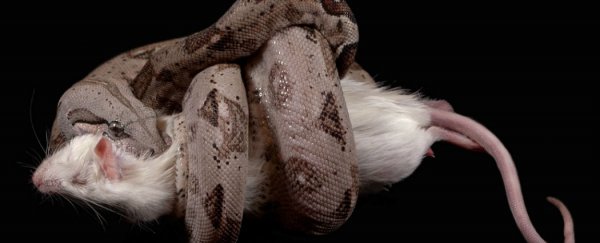Whether or not you've ever ventured into the jungles of South America, you probably have some pretty firm ideas about how boa constrictors deal with their prey - they've featured in plenty of high-profile movies after all. But it turns out the commonly held belief that they suffocate their hapless victims to death may not be true after all.
If you're responsible for a biology textbook or two, you might want to get the printing presses on standby: a new report in the Journal of Experimental Biology says the snakes actually stop the flow of blood around the body, and this kills the unfortunate victim before asphyxiation has a chance to take hold.
Until now, scientists had never conclusively determined how a boa constrictor-induced death actually occurs, but the most common assumption has been asphyxiation. A few researchers have put forward circulatory arrest as an alternative theory, but there's been little hard evidence one way or the other.
To investigate, a team of biologists from Dickinson College in the US used electronic sensors and vascular catheters to measure electrical activity in the heart and the blood pressure of rats offered to a boa constrictor. The boa constrictor was also fitted with a sensor device that could determine how tight it was squeezing at any point during the experiment.
By examining blood samples taken from the rats before and after death, they concluded that the constriction shuts down the flow of blood throughout the body, which leads to the quick death of vital organs such as the brain, liver, and heart.
It makes sense that the boa constrictor would use this MO - circulatory arrest is actually a much deadlier and more efficient technique than asphyxiation. When you suffocate, your heart will keep pumping existing oxygen around your body for some time, which will keep you alive a bit longer. But when the blood flow is cut off, oxygen can't be delivered at all, which means the upside to circulatory arrest is it's a relatively quick way to go, and you'll pass out as soon as your brain runs out of oxygen anyway (fortunately for the rats, they were unconscious from the get-go).
"These results are the first to document the physiological response of prey to constriction and support the hypothesis that snake constriction induces rapid prey death due to circulatory arrest," the researchers conclude.
Now the team wants to try the experiment again with lizards or frogs to see if the type of prey has any effect on how they die - cold-blooded animals don't use oxygen in the same way mammals do.
Study author Scott Boback has spent several years studying snakes and how they deal with their prey. In a report published in 2012, he explained how boa constrictors sensed the heartbeat of their victims and used this to figure out when they were dead.
It's not going to be much consolation if you find yourself up against a boa constrictor on your next trip down the Amazon River, but at least you'll know more about the process.
Here's how it's done:
